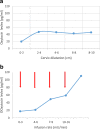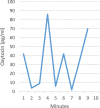Maternal plasma levels of oxytocin during physiological childbirth - a systematic review with implications for uterine contractions and central actions of oxytocin
- PMID: 31399062
- PMCID: PMC6688382
- DOI: 10.1186/s12884-019-2365-9
Maternal plasma levels of oxytocin during physiological childbirth - a systematic review with implications for uterine contractions and central actions of oxytocin
Abstract
Background: Oxytocin is a key hormone in childbirth, and synthetic oxytocin is widely administered to induce or speed labour. Due to lack of synthetized knowledge, we conducted a systematic review of maternal plasma levels of oxytocin during physiological childbirth, and in response to infusions of synthetic oxytocin, if reported in the included studies.
Methods: An a priori protocol was designed and a systematic search was conducted in PubMed, CINAHL, and PsycINFO in October 2015. Search hits were screened on title and abstract after duplicates were removed (n = 4039), 69 articles were examined in full-text and 20 papers met inclusion criteria. As the articles differed in design and methodology used for analysis of oxytocin levels, a narrative synthesis was created and the material was categorised according to effects.
Results: Basal levels of oxytocin increased 3-4-fold during pregnancy. Pulses of oxytocin occurred with increasing frequency, duration, and amplitude, from late pregnancy through labour, reaching a maximum of 3 pulses/10 min towards the end of labour. There was a maximal 3- to 4-fold rise in oxytocin at birth. Oxytocin pulses also occurred in the third stage of labour associated with placental expulsion. Oxytocin peaks during labour did not correlate in time with individual uterine contractions, suggesting additional mechanisms in the control of contractions. Oxytocin levels were also raised in the cerebrospinal fluid during labour, indicating that oxytocin is released into the brain, as well as into the circulation. Oxytocin released into the brain induces beneficial adaptive effects during birth and postpartum. Oxytocin levels following infusion of synthetic oxytocin up to 10 mU/min were similar to oxytocin levels in physiological labour. Oxytocin levels doubled in response to doubling of the rate of infusion of synthetic oxytocin.
Conclusions: Plasma oxytocin levels increase gradually during pregnancy, and during the first and second stages of labour, with increasing size and frequency of pulses of oxytocin. A large pulse of oxytocin occurs with birth. Oxytocin in the circulation stimulates uterine contractions and oxytocin released within the brain influences maternal physiology and behaviour during birth. Oxytocin given as an infusion does not cross into the mother's brain because of the blood brain barrier and does not influence brain function in the same way as oxytocin during normal labour does.
Keywords: Birth; Central effects; Infusion of synthetic oxytocin; Neurobiology; Oxytocin; Physiological labour; Plasma levels; Pregnancy; Uterine contractions.
Conflict of interest statement
The authors declare that they have no competing interests.
Figures




References
-
- du Vigneaud V, Ressler C, Trippett S. The sequence of amino acids in oxytocin, with a proposal for the structure of oxytocin. J Biol Chem. 1953;205(2):949–957. - PubMed
-
- Wakerley JB, Poulain DA, Brown D. Comparison of firing patterns in oxytocin- and vasopressin-releasing neurones during progressive dehydration. Brain Res. 1978;148(2):425–440. - PubMed
-
- Uvnäs Moberg K. Oxytocin: the biological guide to motherhood. Amarillo: Praeclarus Press; 2014.
-
- Sofroniew M. Morphology of vasopressin and oxytocin neurones and their central and vascular projections. Prog Brain Res. 1983;60:101–114. - PubMed
Publication types
MeSH terms
Substances
LinkOut - more resources
Full Text Sources
Other Literature Sources
Medical
Research Materials
Miscellaneous

